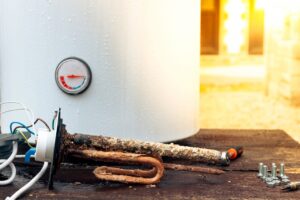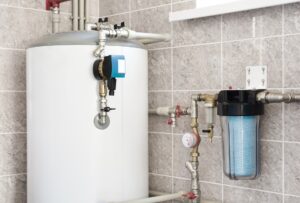Many Washington DC homes have hot water heating systems, also called hydronic systems. They make use of water’s excellent efficiency for transferring heat. Hot water circulates through the house in a network of pipes that connect to radiators or baseboard convectors that transfer the heat to the air. Return pipes cycle the water back to the boiler to be heated again.
The heart of the system is the hot water boiler. As you might expect, boilers get their name because they are boiling water to produce heat. That doesn’t mean there’s a cauldron of water bubbling away inside the boiler’s walls. Water inside the boiler is contained entirely within coils of pipes. Burners beneath the pipes heat the water as it circulates through the pipes. The burners can be gas or oil fired, or electric.
When a pot of water boils on a stove, it sends a lot of heat and steam into the air. Put a lid on the pot and the pressure from the boiling water lifts the lid to allow the steam to escape. Now imagine water being heated inside the coils above the burner. As the pressure builds it has nowhere to go so it drives the water out of the coils and into the network of pipes connecting to the radiators. As it circulates, the hot water pushes the cooler water through the pipes and back down to the boiler. The movement of the water through the system may be assisted by a motor-driven circulating pump connected to the return pipe where it enters the boiler. The pump creates negative pressure that helps cycle the water away from the boiler, through the pipes and radiators, and back to the boiler.
The basic operation of hydronic systems may sound simple, but safely and efficiently controlling it requires a series of sophisticated components. As the water is piped away from the burners and out of the boiler it flows through a valve connected to an expansion tank, which allows the water to expand as it heats. The expansion tank is a large, cylindrical object that hangs off the pipe exiting the boiler.
The large pipe heading away from the expansion tank is divided into a series of smaller pipes, each of which is connected to a zone valve, a small metal box with electrical wires attached to it. The zone valves are wired to the thermostats in the house. When the thermometer in the thermostat drops below the set temperature, it sends a signal to open the zone valve. The hot water from the boiler flows through the valve and into the series of pipes and radiators that service that zone. There may be one, two, or several zone valves depending on the number of zones in the house.
The boiler is also connected to the house water supply so it can be refilled if it loses water. The water supply is usually a small diameter copper pipe exiting the boiler and connected to a shut off valve. The shut off valve also has a pipe leading away from the boiler and connecting to the house’s cold water supply. There is also a pressure relief valve attached to another small diameter copper pipe running out of the boiler. The valve relieves excessive water pressure that builds up inside the boiler.
Oil heat boilers have an electric burner motor that pumps fuel oil out of the tank and into the boiler. The burner motor is attached to the boiler and should have a red reset button that pops up when the boiler shuts down from a malfunction. Gas powered boilers have a smaller gas valve that regulates the flow of gas into the boiler.
Exhaust gases from the burned fuel are vented through a large diameter stack rising up from the center of the boiler and into the chimney. The exhaust stack may be sealed or it may run into an even larger diameter vent with a cone-shaped skirt.
The aquastat is the electrical switching device that ignites the burners when a zone control sends a signal to the boiler calling for heat. The aquastat may be housed in a small metal box attached to the boiler, or it may be inside the boiler. In either case, it will have thick electric cables leading into it. The last critical component on the boiler is the pressure/temperature gauge. If a problem arises with the heating system, it allows the homeowner or the Washington DC boiler technician to determine if the boiler is overheating, losing pressure, or not functioning.
To schedule the annual maintenance for your boiler today, give Polar Bear Air Conditioning a call!
Continue Reading
Tags: Boiler, Boiler Maintenance, Washington DC
Posted in Uncategorized | Comments Off on Washington DC Boiler Basics: Know the Components of Your Hot Water Heating System




